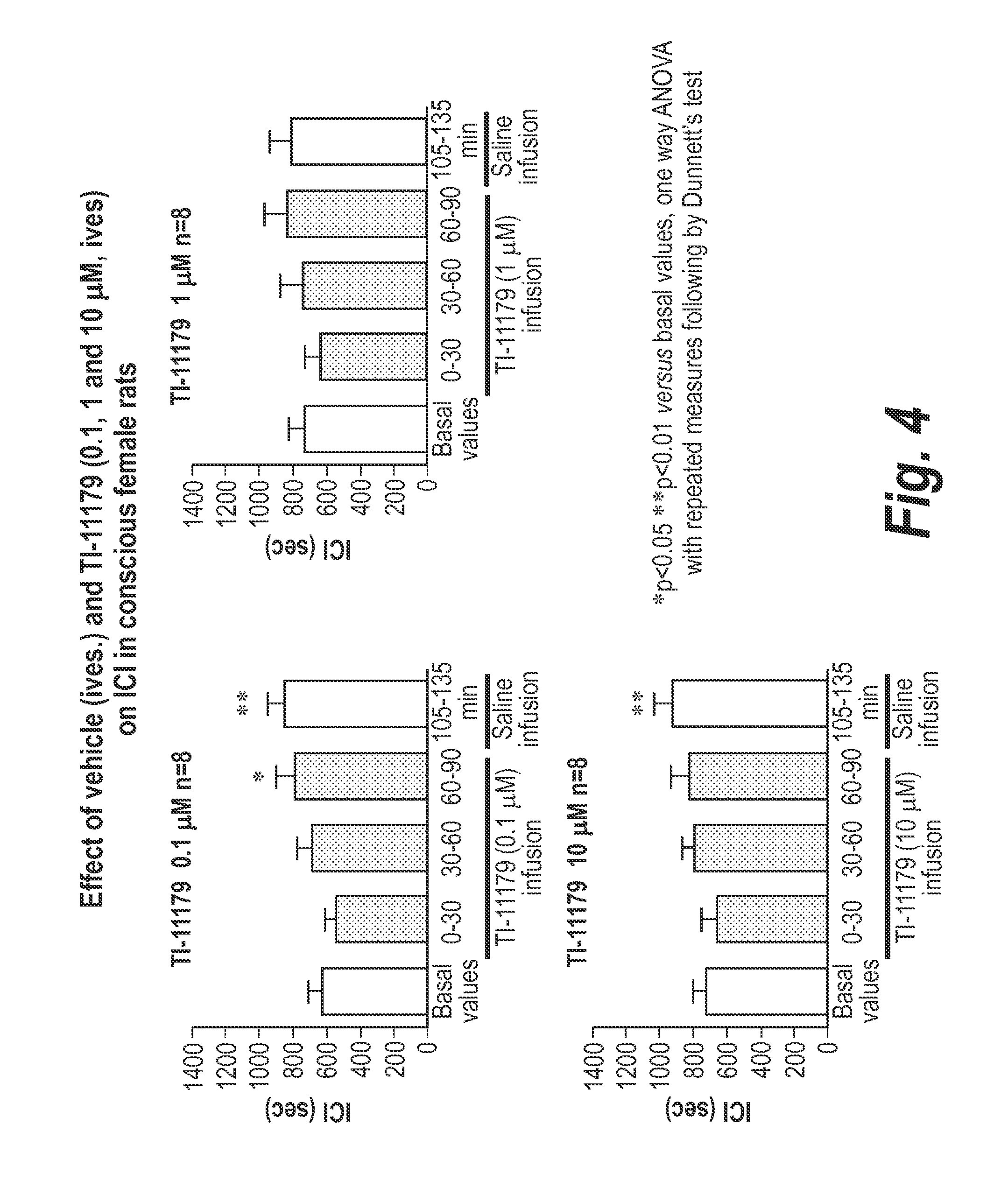Method of treating bladder disorders
a technology of exosmecamylamine and urination frequency, which is applied in the field of exosmecamylamine, can solve the problems of increasing the prevalence of oab, affecting the ability of people to control the bladder and urination frequency, and difficult to determine, so as to increase the micturition interval
- Summary
- Abstract
- Description
- Claims
- Application Information
AI Technical Summary
Benefits of technology
Problems solved by technology
Method used
Image
Examples
example 1
Dexmecamylamine in OAB: Intravesical Model in Conscious Rats
[0105](1) In a first study (performed by UROsphere), female Sprague Dawley rats (200-270 g) from Charles River France, housed in 3-4 rats per cage were anesthetized with isoflurane (1.5-3%). Two days after cystometry, a polyethylene catheter was implanted in the bladder through the dome and exteriorized at the scapular level. Each rat was housed individually after surgery. The cystometry is depicted in FIG. 2. This is the first known experiment using the intravesical model in conscious rats to test dexmecamylamine for potential efficacy in treating OAB.
[0106]The effects of dosing exo-R-mecamylamine (also referred to as TC-5213 and as TI-11178), at doses of 0.1, 1, and 10 μM are depicted in FIG. 3.
[0107]The effects of dosing dexmecamylamine (also referred to as TC-5214 and as TI-11179), at doses of 0.1, 1, and 10 μM are depicted in FIG. 4.
[0108]The effects of dosing hexamethonium (10 μM) and tolterodine (10 μM) are depicted ...
example 2
Dexmecamylamine in OAB: Intravesical Model in Anesthetized Rats
[0113]Female Sprague Dawley rats (200-290 g) from Charles River France, housed in 3-4 rats per cage were anesthetized with urethane (1.2 g / kg) s.c., 3 mL / kg). A polyethylene catheter was implanted into the bladder through the dome. Ureters were tied and cut. Intravesical infusion periods with saline followed by an intravesical infusion period with one of the test compounds, hexamethonium (10 μM) or dexmecamylamine (1 and 10 μM), are depicted in FIG. 7.
[0114]The intravesical anesthetized rat model is a model of increased bladder contraction frequency. The model is a “simplified” well established model used to evaluate OAB agents, recognizing that there are decreased inputs from cortical centers. This is the first known experiment using the intravesical anesthetized rat model of increased bladder contraction frequency to test dexmecamylamine for potential efficacy in treating OAB.
[0115]As shown in FIGS. 8-12, dexmecamylami...
example 3
Oral Agent for Intravesical Drug Delivery
[0119]One aspect of the present invention is the use of dexmecamylamine as an oral agent for intravesical drug delivery. Oral doses (up to 4 mg BID) of dexmecamylamine evaluated during clinical studies for depression produced concentrations in the bladder in excess of 10 μM. As shown above, similar concentrations of hexamethonium produce meaningful changes in the frequency of bladder contraction. Nicotinic receptors, including α3, α7, and β4, are expressed in the bladder urothelium itself. Agents that block nicotinic receptors in the bladder, such as hexamethonium, decrease bladder contractions and may block sensation of urgency. Inhibition of the α3 receptor diminishes bladder contraction frequency and afferent signaling to the brain (via P2X), thereby blocking or reducing the sensation of urgency. Support for this mechanism includes experiments demonstrating that A3-knockout rodents exhibit distended bladders. (Xu et al., Megacystis, mydria...
PUM
| Property | Measurement | Unit |
|---|---|---|
| Fraction | aaaaa | aaaaa |
| Time | aaaaa | aaaaa |
| Mass | aaaaa | aaaaa |
Abstract
Description
Claims
Application Information
 Login to View More
Login to View More - R&D
- Intellectual Property
- Life Sciences
- Materials
- Tech Scout
- Unparalleled Data Quality
- Higher Quality Content
- 60% Fewer Hallucinations
Browse by: Latest US Patents, China's latest patents, Technical Efficacy Thesaurus, Application Domain, Technology Topic, Popular Technical Reports.
© 2025 PatSnap. All rights reserved.Legal|Privacy policy|Modern Slavery Act Transparency Statement|Sitemap|About US| Contact US: help@patsnap.com



